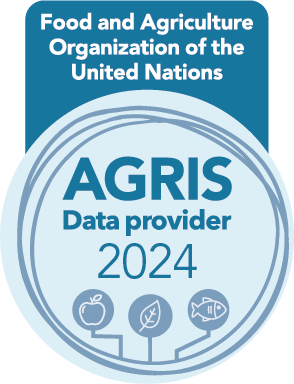Molecular characterisation, biology, behaviour and feeding potential of a novelpredator of the mango ecosystem: Sycanus bifidus (Fabricius, 1787)
DOI:
https://doi.org/10.24154/jhs.v19i2.2336Keywords:
Feeding potential, mango, molecular characterization, predatory efficiency, Sycanus bifidusAbstract
This study provides an overview of the comprehensive study on Sycanus bifidus, a new generalist predatory fauna collected from mango ecosystem, encompassing its molecular characterization, biology, behaviour and feeding potential. The research delves into the intricate details of S. bifidus, shedding light on its morphological features, and ecological significance. Molecular characterization techniques, including DNA sequencing and genetic analysis, play a pivotal role in elucidating the species genetic makeup, population dynamics, and potential adaptations. The study also explores the intricate biology and behaviour of S. bifidus. Furthermore, the research investigates the feeding potential of S. bifidus, emphasizing its role as a predator in controlling pest populations. An in-depth analysis of its feeding habits, and efficiency as a biological control agent provides valuable information for the development of sustainable pest management strategies.
Downloads
References
Abdul, S., Wahyu, D. N., Hersanti, F., & Sudarjat, N. (2018). Laboratory rearing of Sycanus annulicornis (Hemiptera: Reduviidae) on two species of prey: Differences in its biology and efficiency as a predator of the nettle caterpillar pest Setothosea asigna (Lepidoptera: Limacodidae). European Journal of Entomology, 115, 208–216. https://doi.org/10.14411/eje.2018.019
Ambrose, D. P. (1980). Bioecology, ecophysiology and ethology of reduviids (Heteroptera) of the scrub jungles of Tamil Nadu, India (Ph.D. thesis). University of Madras, Madras, India.
Ambrose, D. P. (1999). Assassin Bugs. Oxford & IBH Publishing Co. Pvt. Ltd., New Delhi, India, and Science Publishers, Inc., New Hampshire, USA.
Ambrose, D. P. (2003). Biocontrol potential of assassin bugs (Hemiptera: Reduviidae). Indian Journal of Experimental Zoology, 6(1), 1–44.
Ambrose, D. P. (2006). A checklist of Indian assassin bugs (Insecta: Hemiptera: Reduviidae) with taxonomic status, distribution and diagnostic morphological characteristics. Zoos’ Print Journal, 21(9), 2388–2406. https://doi.org/10.11609/JoTT.ZPJ.871.2388-406
Ambrose, D. P., & Claver, M. A. (2001). Survey of reduviid predators in seven pigeonpea agroecosystems in Tirunelveli, Tamil Nadu, India. International Chickpea and Pigeonpea Newsletter, 8, 44–45.
Biswas, B., & Mitra, B. (2011). Checklist of Indian Assassin Bugs (Insecta: Hemiptera: Reduviidae). Zoological Survey of India. http://zsi.gov.in/checklist/reduviidae.pdf
Das, S. S. M., & Ambrose, D. P. (2008). Redescription, biology and behaviour of the harpatocorine assassin bug Irantha armipes (Stål) (Hemiptera: Reduviidae). Acta Entomologica Slovenica, 16, 37–56.
Distant, W. L. (1904). The fauna of British India, including Ceylon and Burma: Rhynchota (Vol. 2). Taylor and Francis, London.
Distant, W. L. (1910). The fauna of British India, including Ceylon and Burma: Rhynchota (Vol. 5). Taylor and Francis, London.
Maldonado, C. J. (1990). Systematic catalogue of the Reduviidae of the world. Caribbean Journal of Science, Special Publication No. 1, University of Puerto Rico, Mayagüez, Puerto Rico.
Nitin, K. S., Bhat, P. S., Raviprasad, T. N., & Vanitha, K. (2017). Biology, behaviour and predatory efficiency of Sycanus galbanus Distant (Hemiptera: Reduviidae: Harpactorinae) recorded in cashew plantations. Journal of Entomological and Zoological Studies, 5(2), 524–530.
Rajan, S. J., Suneetha, N., & Sathish, R. (2017). Biology and predatory behaviour of an assassin bug, Sycanus collaris (Fabricius) on rice meal moth, Corcyra cephalonica (Stainton) and leaf armyworm, Spodoptera litura (Fabricius). Agriculture Update, 12(5), 1181–1186. https://doi.org/10.15740/has/au/12.techser(5)2017/1181-1186
Sahayaraj, K. (2004). Reduviids in biological control. In K. Sahayaraj (Ed.), Indian Insect Predators in Biological Control (pp. 134–176). Daya Publishing House, Delhi, India.
Sahayaraj, K., & Balasubramanian, R. (2016). Reduviid: An important biological control agent. In Artificial rearing of reduviid predators for pest management (pp. 1–28). Springer, Singapore. https://doi.org/10.1007/978-981-10-1498-0_1
Shanker, C., Lydia, C., Sampathkumar, M., Sunil, V., & Katti, G. (2016). Biology and predatory potential of Rhynocoris fuscipes (Fabricius) (Hemiptera: Reduviidae) on the rice leaf folder Cnaphalocrocis medinalis (Guenee). Journal of Rice Research, 9, 47–49.
Srikumar, K. K., Bhat, P. S., Raviprasad, T. N., Vanitha, K., Saroj, P. L., & Ambrose, D. P. (2014). Biology and behavior of six species of reduviids (Hemiptera: Reduviidae: Harpactorinae) in a cashew ecosystem. Journal of Agricultural and Urban Entomology, 30(1), 65–81. https://doi.org/10.3954/jaue14-14.1
Tamura, K., Stecher, G., & Kumar, S. (2021). MEGA11: Molecular evolutionary genetics analysis version 11. Molecular Biology and Evolution, 38, 3022–3027. https://doi.org/10.1093/molbev/msab120
Truong, X. L., Pham, H. P., & Thai, T. N. L. (2020). Biology and predatory ability of the reduviid Sycanus falleni Stål (Heteroptera: Reduviidae: Harpactorinae) fed on four different preys in laboratory conditions. Journal of Asia-Pacific Entomology, 23(4), 1188–1193. https://doi.org/10.1016/j.aspen.2020.09.015
Weirauch, C., Bérenger, J. M., Berniker, L., Forero, D., Forthman, M., Frankenberg, S., Freedman, A., Gordon, E., Hoey-Chamberlain, R., Hwang, W. S., Marshall, S. A., Michael, A., Paiero, S. M., Udah, O., Watson, C., Yeo, M., Zhang, G., & Zhang, J. (2014). An illustrated identification key to assassin bug subfamilies and tribes (Hemiptera: Reduviidae). Canadian Journal of Arthropod Identification, 26. https://doi.org/10.3752/cjai.2014.26
Zhao, P., Chen, S., Liu, Y., Wang, J., Chen, Z., Li, H., & Cai, W. (2024). Review of the genus Sycanus Amyot & Serville, 1843 (Heteroptera: Reduviidae: Harpactorinae), from China based on DNA barcoding and morphological evidence. Insects, 15, 165. https://doi.org/10.3390/insects15030165
Downloads
Published
Data Availability Statement
NA
Issue
Section
License
Copyright (c) 2024 S N Bhagyasree, Gundappa Baradevanal, Nidhi Kumari (Author)

This work is licensed under a Creative Commons Attribution-NonCommercial-ShareAlike 4.0 International License.
Authors retain copyright. Articles published are made available as open access articles, distributed under the terms of the Creative Commons Attribution-NonCommercial-ShareAlike 4.0 International License, which permits unrestricted non-commercial use, distribution, and reproduction in any medium, provided the original author and source are credited. 
This journal permits and encourages authors to share their submitted versions (preprints), accepted versions (postprints) and/or published versions (publisher versions) freely under the CC BY-NC-SA 4.0 license while providing bibliographic details that credit, if applicable.











 .
. 













